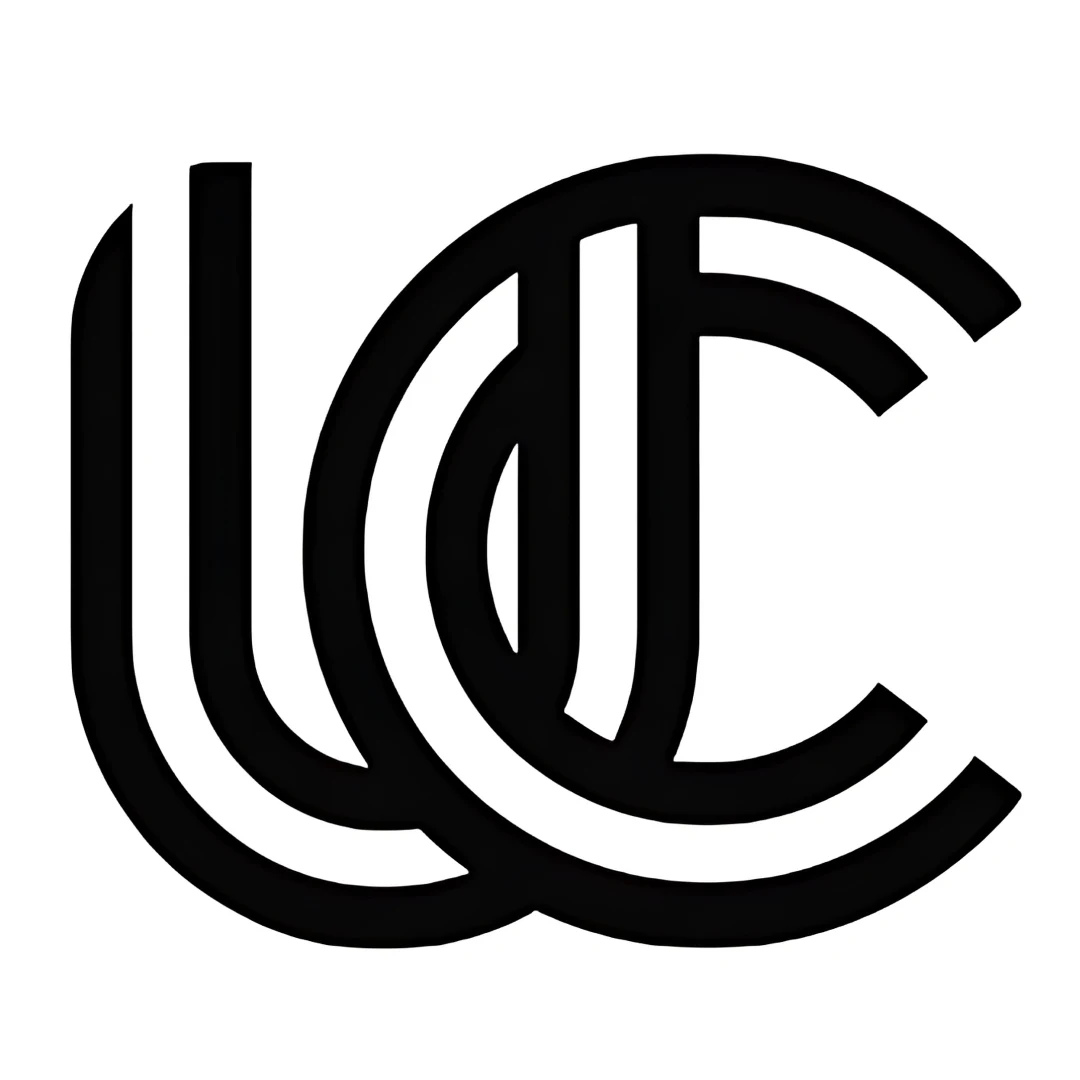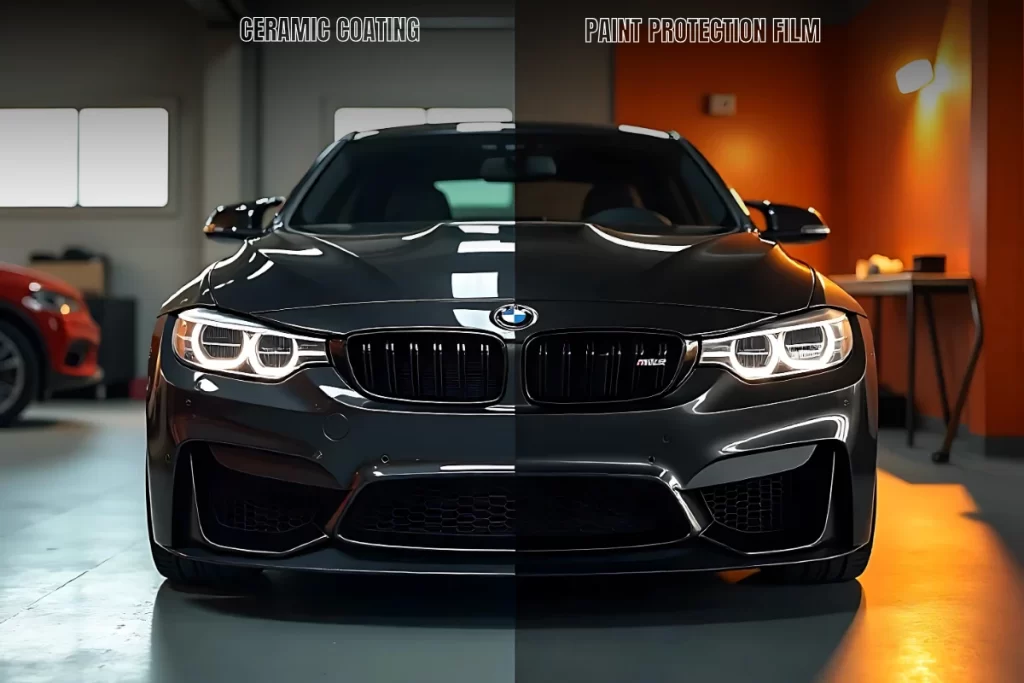
Deciding between PPF coating versus ceramic coating is always a difficult battle for the customer, weighing which option offers the most protection. The crucial factor to consider in paint protection for your car is to understand both of these options. PPF protects the paint for up to 7-10 years with almost self-healing capacity for very small scratches, while ceramic coating offers 2-5 years with very good hydrophobic properties.
As we car owners noticed, paint protection has been starting to demand in India, greatly because of the huge price difference- PPF installation goes from ₹50,000 to ₹2,00,000, and ceramic coatings only cost ₹15,000 to ₹45,000. That price difference essentially points out the different protective capabilities- PPF goes against impact from the rock chips and scratches very nicely, so it is best suited for harsh road conditions. Ceramic finishes, on the other hand, offer more gloss and a showroom-like finish for easier cleaning.
What is Paint Protection Film PPF ?
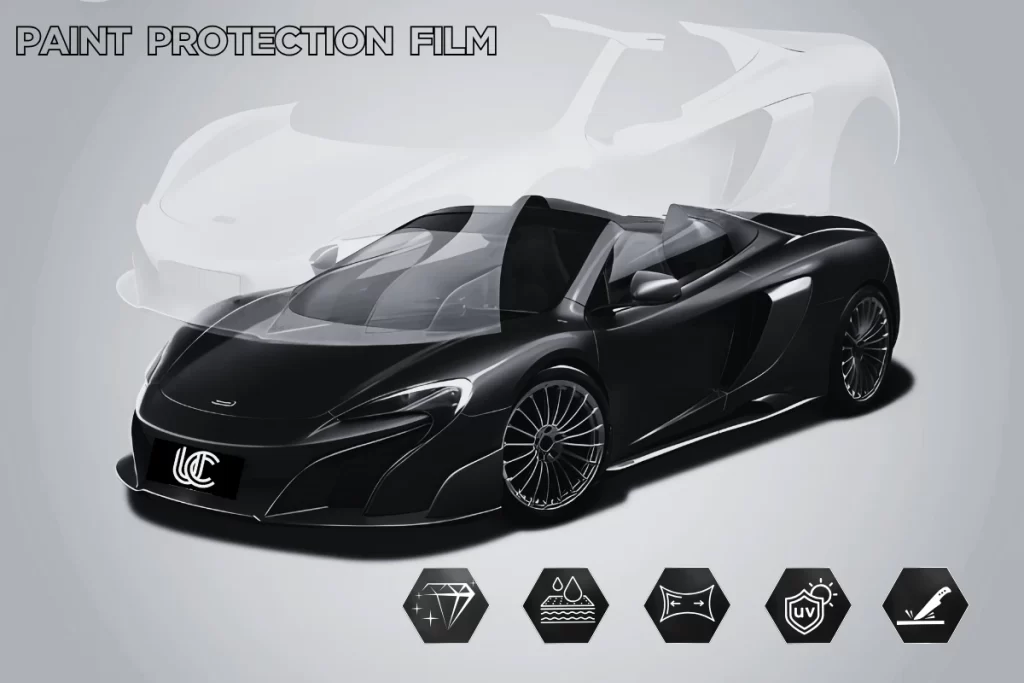
Paint Protection Film (PPF) represents a breakthrough in vehicle preservation technology—a transparent thermoplastic urethane film applied to painted surfaces of automobiles. This virtually invisible shield, often referred to as “clear bra,” creates a powerful barrier between your car’s paint and potential damage. Unlike traditional protection methods, PPF is a physical layer measuring 6-8 mils in thickness that conforms perfectly to your vehicle’s contours.
How PPF works: Layers and self-healing
Modern PPF consists of multiple sophisticated layers working together to safeguard your vehicle. The structure typically includes:
- A clear top coat layer with self-healing properties
- A thick polyurethane core that absorbs impacts
- An acrylic adhesive layer that bonds to the paint
- A protective liner is removed during installation
The cool self-healing ability of this film comes from soft, stretchy stuff called elastomeric polymers—think of them like those stretchy rubber bands you play with. If your car gets tiny scratches, you can fix them by adding a bit of heat, like from the sun, some warm water, or a heat gun, to get the materials to do their thing and smooth out the scratches. The heat helps the polymers go back to their original shape, which makes the scratches on the film disappear, almost like healing the surface. Just so you know, this doesn’t fix dents on your car’s paint—it only works on the film by shifting its tiny pieces around to smooth out those scratches.
Types of PPF: Glossy, matte, black, clear
PPF comes in several varieties to match different aesthetic preferences and protection needs:
Gloss Paint Protection Film
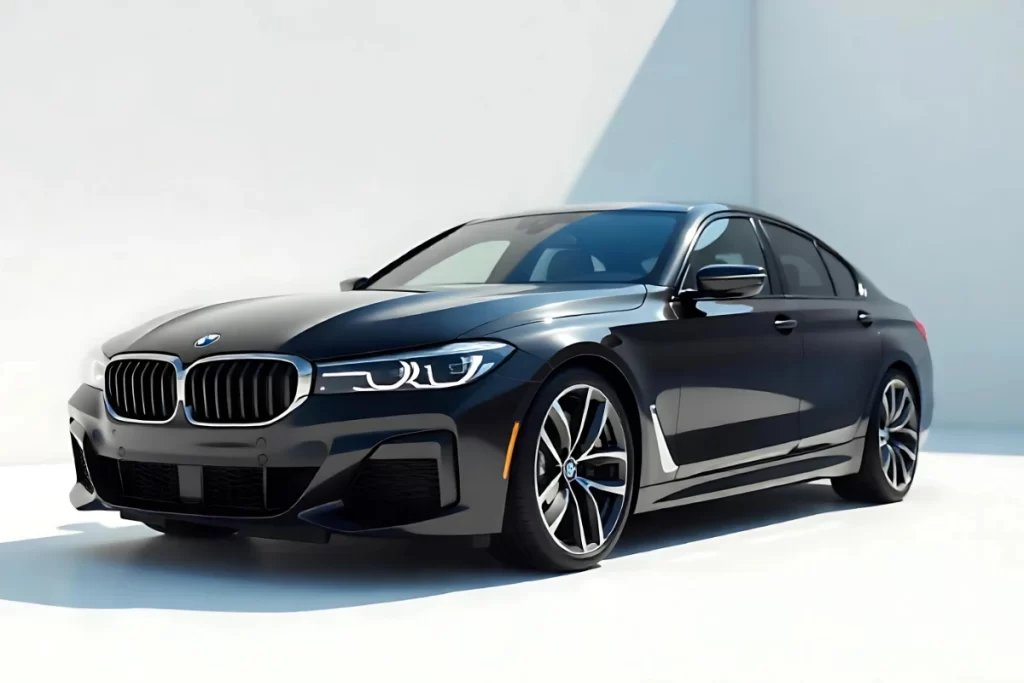
The choice of the majority of car owners, Gloss PPF is there for making a vehicle super shiny and safe. This film has glossy finishes that bring out the natural shine of your car paint so that it remains freshly polished at all times. In a way, it feels just like an offering of an extra layer of clear coat, although therein lies the protective benefit for scratches, rock chips, and UV rays. If you fancy a car that glistens in the sun and want to somehow preserve it without altering its style, this is it! Good for a vehicle painted in bright or deep colors where a glossy effect really comes into view.
Matte PPF Paint Protection Film
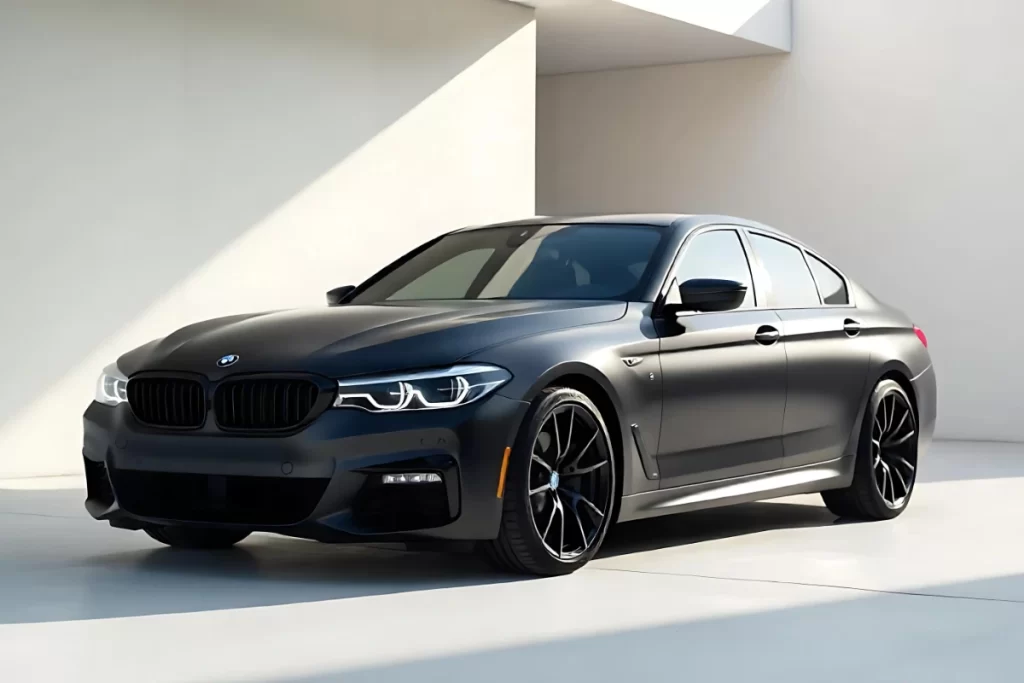
Matte PPF lends your car a clean, non-shiny exterior. If your car already comes finished in matte paint, or you want to make a sudden change to a more subdued modern personality, this is it. And unlike glossy films, matte PPF does not bounce the rays back; instead, it grants a silken smooth finish, almost velvety to look upon. Protective against any scratches, chips, or sun damage, the treatment is mostly about how it looks. Commonly, this is the go-to finish for custom cars or high-end models-it gives the car a distinctive spirit without shouting over it.
Colored PPF Paint Protection Film
Colored PPF is a delightful option because it lets you protect your car while adding a pop of color. This type of film is offered in many shades so that one can change the appearance of the car without altering its original paint underneath. Does the colored PPF make a car look red or blue, or have a metallic tint? It is like giving a car a fresh outfit while ensuring it is protected from scratches and UV rays. And the best part, should you want to go back to your car’s original color in the future, all you need to do is peel off the film, leaving the paint beneath unharmed. It is an excellent way to mess around with car styles without committing.
Clear PPF Paint Protection Film
Clear offers the most understated look-it can be said to be nearly invisible once installed on a vehicle. The film was made to safeguard the vehicle without actually affecting its appearance. If you really like the original color of your car and would not dare to have anything change the original hue on it, then clear PPF is your best choice. It protects against scratches, small stones, and sunlight but remains unnoticed. So the PPF is an unnoticeable shield to defend the paint of the car! Clear PPF is often chosen by people who want to protect the vehicle paint but do not want it to have any extra shine or color.
Textured PPF Paint Protection Film
Textured PPF is for those who desire a little bit different. This type of film comes with special patterns such as carbon fiber and forged carbon, which give your car a unique, custom look. It is not just about protection; there is a texture added to make the car stand out. A carbon fiber pattern, for example, makes the car sportier and higher-tech, the kind of image you will see in a racing movie. Textured PPF protects the car from scratches and UV rays; however, it is more inclined toward style. It is a perfect treat for those car nuts who want to throw a little bit of personality into a car being kept safe.
Instant Healing PPF Paint Protection Film
This is the most advanced type of PPF on the list. Unlike any of the other films, this one’s scratches do not need to be warmed up by the heat of the sun or a heat gun to heal as they can heal right after the event, without any help at all. It is made by using a special technology that allows the film to smooth over minor scratches and swirl marks as soon as they are made. So, if you just brush against the bush or get a light scratch, the film will heal itself almost instantaneously.
Benefits of PPF coating for cars
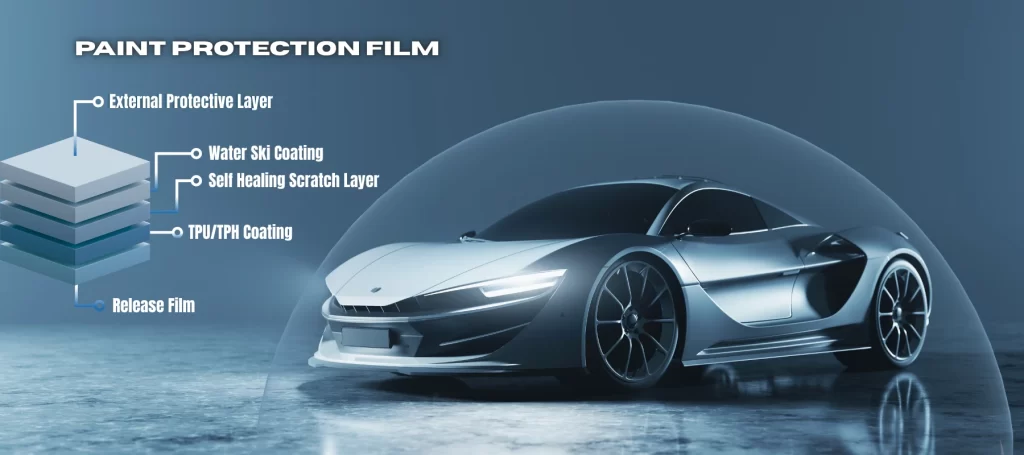
Paint Protection Film (PPF) has so many benefits besides simple protection. Being hydrophobic, the film repels water, limescale, and resins, allowing for easier cleaning. The polyurethane layer can also absorb impacts from flying debris, gravel, and stone chips by dispersing the force over an area.
This protective shield helps in preserving the car’s resale value by safeguarding the original state of the paint. Moreover, PPF provides great UV protection, saving the paint from the premature fate that is so common under the scorching sun of India.
Admittedly, if installed well, a good-quality PPF can last anywhere between 5 to 10 years, depending on the brand of PPF and the environmental conditions, thus being a long-term investment towards their looks.
What is Ceramic Coating?
Ceramic coating emerges as a liquid polymer containing silica-based compounds that permanently bond to your vehicle’s paint. Unlike temporary waxes, this advanced technology creates a semi-permanent protective layer through a chemical bonding process. The coating typically contains silicon dioxide (SiO2) and sometimes titanium dioxide (TiO2), forming a robust shield against environmental threats.
How ceramic coating bonds with paint
The science behind ceramic coating involves sophisticated chemistry. These coatings contain polydimethylsiloxanes (PDMs) that create a clear, glossy, and thermally stable surface. Once applied, the coating’s resins, solvents, and additives work together to form a chemical bond with your car’s paint at a molecular level. This creates a lattice-like structure that fills microscopic imperfections in the paint surface. Consequently, the coating becomes virtually impossible to wash away or remove without specialized processes, much like staining wood rather than simply painting it.
Application process and curing time
The professional application of ceramic coating requires a step-by-step approach. Before anything else, the vehicle goes through a thorough washing and decontamination procedure. All dirt, grease, and wax residues must be eliminated from the surface. Once that is done, paint correction polishing takes place to remove swirl marks and any imperfections, making a perfect foundation. After correction, the coating is applied in small sections, carefully working with an applicator pad.
After the application, the ceramic coating needs to cure. This usually consists of two phases, the first being an initial dry time of around 24 to 48 hours, where the vehicular surface must not spell water. Then, during full cure time, it takes away from 7-14 days to reach full hardness and efficiency; however, this period greatly depends on the temperature and humidity of the environment.
Advantages of ceramic coating for car owners
Ceramic coating offers wonderful benefits for any car enthusiast. It offers a hydrophobic surface, which means that water drops idolize and roll down, taking dirt with them. Also, it would be a good idea to emphasize the coating’s protection against UV rays that otherwise cause paint oxidation and fading in heavy Indian sunlight. The increased gloss presents the vehicle with a showroom shine finish and subsequently increases its visual appeal. A good-quality ceramic coating, if taken care of well, can last anywhere from 2 to 5 years; this definitely proves to be a cheaper alternative when compared to waxing the car from time to time.
PPF vs Ceramic Coating: Feature-by-Feature Comparison
When comparing these two protective options, understanding how they perform in specific categories helps make an informed decision for your vehicle’s needs.
Scratch and impact resistance
PPF clearly dominates in physical protection. Its thicker composition creates a sacrificial barrier that absorbs impacts from flying debris, rocks, and road hazards. The self-healing properties allow PPF to recover from minor scratches and swirl marks with heat application. Ceramic coating, despite its impressive 9H hardness rating, cannot match PPF’s ability to protect against physical impacts and deep scratches. However, ceramic coatings remain easier to repair than completely replacing damaged PPF sections.
Hydrophobic properties and ease of cleaning
Ceramic coating excels in this category with superior hydrophobic performance. Its chemical structure causes water to bead up and roll off, taking contaminants with it. This self-cleaning effect makes maintenance significantly easier. Although some PPF products feature hydrophobic top layers, they typically don’t perform at the same level as dedicated ceramic coatings.
UV and chemical protection
Both options provide UV protection, albeit differently. Quality ceramic coatings create a chemical shield against harmful rays, preventing oxidation and fading. Traditional PPF products may yellow or discolor with excessive sun exposure, though premium aliphatic TPU films resist this issue.
Durability and lifespan
PPF generally lasts 5-10 years with proper care, outperforming ceramic coatings that typically provide 2-5 years of protection. The durability difference reflects their distinct protective mechanisms—PPF offering physical barrier protection versus ceramic’s chemical bonding approach.
Installation time and complexity
PPF installation requires meticulous precision, taking anywhere from 1-2 days for partial coverage to 3-5 days for complete vehicle protection. Conversely, ceramic coating application involves thorough cleaning, paint correction, and a crucial curing period of 24-48 hours initial drying plus 7-14 days for full hardening.
PPF coating vs ceramic coating price
The price difference is substantial. PPF installation ranges from ₹45,000 to ₹1,50,000+, depending on coverage area and quality. For specific vehicle types:
- SUVs: ₹1,25,000 for PPF vs ₹25,000 for ceramic coating
- Hatchbacks: ₹80,000 for PPF vs ₹20,000 for ceramic coating
- Sedans: ₹1,00,000 for PPF vs ₹22,000 for ceramic coating
Real-World Results and Customer Experiences
To truly understand the effectiveness of vehicle protection options, we examined real-world tests and gathered feedback from actual owners. The results reveal practical differences between these competing technologies.
Test 1: Scratch resistance in daily use
In grocery store parking lots, PPF consistently outperforms ceramic coating when facing common hazards. While ceramic coatings resist light swirl marks, they can’t prevent deeper scratches. In contrast, high-quality PPF absorbs impacts from flying debris and demonstrates impressive self-healing properties—minor scratches disappear with heat exposure, restoring the film to its original state.
Test 2: Water beading and cleaning ease
Ceramic coatings excel in hydrophobic performance. The beading effect causes water to roll off immediately, taking dirt particles along with it. According to multiple detailers, ceramic-coated vehicles require up to 50% less frequent washing compared to unprotected cars. Meanwhile, standard PPF offers minimal hydrophobic properties, making it more vulnerable to water spots unless combined with a ceramic topcoat.
Test 3: UV exposure and paint fading
Under India’s intense sunlight, ceramic coating creates a chemical shield against harmful rays, preventing oxidation. Nevertheless, inferior PPF materials can turn yellowish or discolored with excessive sun exposure. Premium aliphatic TPU films resist this issue, maintaining clarity even after years of exposure.
Test 4: Resale value after 2 years
According to Auto Trader studies, vehicles with either protection command higher resale values than unprotected ones. PPF-protected cars specifically maintain their factory-finish appearance, eliminating the need for repainting—a factor that significantly impacts resale negotiations.
Customer reviews from Indian cities
A Mumbai-based SUV owner reported that after six months with ceramic coating, light swirl marks appeared despite careful maintenance. Annual detailing was necessary to restore the finish. Conversely, Delhi drivers with PPF installations noted virtually unchanged surfaces even after two years in heavily polluted conditions.
Detailer feedback on ceramic vs PPF coating
Professional detailers frequently recommend combining both solutions—applying ceramic coating over PPF—for ultimate protection. This approach provides physical impact resistance while enhancing hydrophobic properties.
Conclusion
After going over both PPF and ceramic coating, the precise decision is dictated by your specific needs and priorities. PPF for sure offers hardcore protection from road debris, wildfire scratches, and stone chips. In addition to these, its sometimes-healing properties make it the best choice for vehicles regularly driven on highways or rough terrain. Such is not the case with the top hydrophobic qualities and showroom finish it happens to have, being some ceramic coating at an affordable price! For the best protection at any price, we recommend the application of ceramic coating upon PPF. Hence, PPF offers resistance to physical impact, augmented by the brilliant shine and hydrophobic properties of the ceramic coating. Thus, even though upfront costs are certainly higher, the combination layer best shields your vehicle paint.
Your decision should factor in several key considerations. First, the driving environment should be weighed; in cities with tight parking spaces, scratch resistance demanded by PPF holds more importance, whereas a ceramic coat will be ample for a vehicle primarily driven on good roads. Second, factor in the approximate ownership time; economically, PPF pays if the owner has a plan of 5+ years because of its lifespan. Last, budget constraints; having more initial kitty matters since PPF requires a much higher price upfront.
Regardless of whichever option is chosen, both PPF and ceramic coatings are great investments that protect a vehicle’s aesthetics and keep resale value in check. Besides, their installation will surely lower the maintenance level as compared to that of an unprotected vehicle. For most enthusiasts and practical owners alike, the peace of mind, along with the thought that their car’s paint is safe from environmental hazards, will be worth the price.
